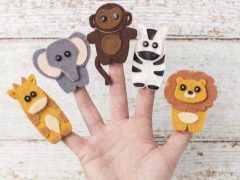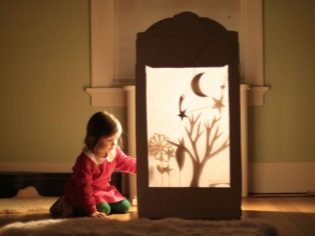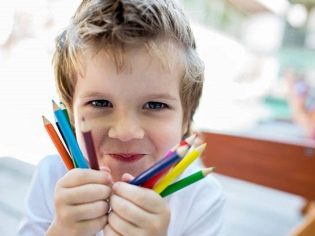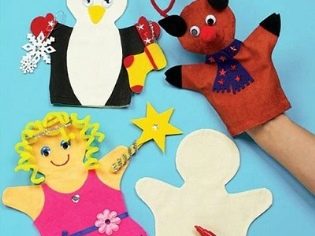Kukloterapiya as a psychological assistance to the child
The gameplay is the most natural for children, it gives them pleasure. But playing with dolls is not only fun, but also healing. The method of psychological correction, which was called "doll therapy", will help with a variety of problems in the development of the child. In this article we will tell about the essence of the method, as well as how to organize activities for the baby on your own.
What it is?
Kukloterapiya - a form of psychocorrection, which can be used for children from the year, as well as for preschoolers, younger and middle schoolchildren. Practically up to adolescence, some techniques and the basis of this art-therapeutic positive technique can be applied with continued success.
Interaction with the dolls allows the child to better understand their own place in this world, it is easier to express their emotions in words. It is not always easy for children to talk about what worries and cares about them, about what they fear directly. It is much easier to transfer your fears, offenses, anxieties and other strong destructive emotions to something inanimate - on a sheet of paper (when drawing), on a figure (when modeling), on dolls, playing a performance in a special puppet theater.
This The method is recognized worldwide as one of the most effective methods of psychological assistance to children., which allows to improve their social adaptation, resolve internal and external conflicts. A kid can, with the help of dolls with the help of adults who are familiar with the basics of the technique, play out any situation that, in one way or another, concerns him and injures him.
Different experts attribute the method to different areas of psychological knowledge: psychodrama, game therapy. More often, it is considered one of the types of art therapy or, in general, is isolated into a separate form.
History reference
Even in the most ancient times, adults noticed that children love to play with dolls. They were made from grass, straw, birch bark, wood, fruit, cloth. In Russia, the newborn be sure to make a doll charm with their own hands. It was believed that such a doll would protect the baby from evil spells, from diseases and troubles. His puppet doll was kept in men and women throughout life.
The doll, according to the observations of the parents, was not only a toy, but also a real friend to the baby - he ate better if he took the doll with him, slept better, if she was also in bed or in the cradle. On the dolls, the child “trained” the first adult skills: responsibility, care (the dolls were “healed”, “taught”, “fed” and dressed). At a certain age, all children firmly believe that the dolls are alive, they just carefully hide it from adults. The best fairy tales of all times and peoples are based on this: the revived Buratino, the Nutcracker and other characters.
First, this strong link between children and toys offered to use the daughter of the famous psychoanalyst Sigmund Freud Anna for therapeutic and diagnostic purposes. But her works became only the basis for the majority of studies that conducted (and finally formed the methodology) Soviet scientists Irina Medvedeva and Tatyana Shishova. Their work became the basis of the method of puppet therapy.. And it is necessary to treat the method not just as fashionable entertainment, but as a method of work with children and adolescents, confirmed by a strong scientific base.
Types and methods
Kukloterapiya is individual and group. In the first case, the lesson is held with one child, in the second - with a group of children.Further, the classification implies differences in functions.
Kukloterapiya happens:
- communicative - aimed at improving the ability to communicate, build relationships between children in a team, and build relationships between an adult and a child;
- relaxation - aimed at eliminating psychological blocks, fears, emotional stress of the child;
- pedagogical - teaching new knowledge, skills conducive to expanding the horizons of the baby;
- corrective - aimed at correcting behavioral problems, as well as problems with speech (used as an auxiliary method in speech therapy) and mental development;
- developing - aimed at the development of memory, attention, motor skills, speech.
In the overwhelming majority of cases, within one class, several techniques are combined. Thus, in autism, the child is shown communicative, pedagogical and corrective puppet therapy, and in case of hyperactivity and attention deficit, a combination of teaching and corrective techniques.
According to the type of dolls used, several important trends and types of puppet therapy are also distinguished.
- Puppets - dolls on threads that can be controlled. With their help, they arrange a puppet theater, fairy tales in which both adults play for a child as part of a training session, and children play for adult viewers as part of a relaxation method.
- Gloves - dolls mittens with a hard head and a soft body, worn on the arm. With their help, motor skills, coordination of movements and speech, thinking and logic develop.
- Fingertips - These are dolls that are optimal for homework, because you can make them from any small plastic ball simply by cutting a finger hole in it and drawing a muzzle on the ball. Useful in all forms of puppet therapy.
- Ropes - These are rather abstract dolls that are not suitable for babies, it is best to spend with them relaxation and correctional classes for older children. Made from ropes looped weaving.
- Flat - figures, cut from cardboard, plastic, paper. They are useful for developing and training activities, since in most cases it is proposed to make them to the child himself.
- Shadow - any figures, including flat ones, intended for the theater of shadows. Good for children of all ages.
- Growth - These are human-sized dolls, representing a costume for a man. It is very useful not only as a funny animator for a children's birthday, but also for psycho-correction of various conditions, they are not suitable for young children - they are afraid of them in most cases.
The method does not imply the need to buy or make any one type of dolls. For home classes absolutely any dolls that are available will be suitable, as well as a mass of available tools: rags, old clothes, scarves, unwanted boxes and bubbles. Dolls can be made from everything.
What problems solves?
At first glance, the doll cannot solve serious problems, but it is only at first glance. The interaction of the child with the doll, which he identifies with something important for himself, and often with himself, helps diagnose many problems of childhood, including psychological and even psychiatric problems.
Properly built Lesson allows you to teach your child to express their emotions, to talk about what disturbs him, which is very important for shy and reticent children, kids with communication problems, with autism spectrum disorder; for children who have suffered serious stress, tragedy, violence, have suffered psychological trauma. Kukloterapiya useful for adapting a child to new conditions: a visit to the kindergarten began, the family moved to a new place of residence, mom and dad divorced, etc. Exercises accompanied by parents and children will help to establish contact with the latter second, if it is broken.
The combination of speech therapy classes with non-traditional technologies, which include puppet therapy, gives excellent results in speech correction: with alalia, stuttering and other problems of speech development. Naughty children, neurotics and hysterical kids with the help of puppet theater get the opportunity to look at their behavior from the outside, which is an effective form of behavior correction.
Dolls can “tell” and “explain” what children do not listen to if they are told about it in everyday life: about the need to wash their hands, brush their teeth, clean the bed, etc. In the performance of the dolls even simple truths become more understandable and intelligible.
How to organize self-study?
If parents treat their child to a psychologist, a puppet therapist, he usually has a lot of different dolls in his office, the child can choose any. But at home, the organization of classes is considered optimal, in which child makes a doll himself or with the help of adults. It is clear that this method is not suitable for very young children, but from the age of one and a half the child can take an active part in creating dolls for the next treatment session. Therefore, in the first stage, you need to make dolls.
There is not much difference in what they will be made of, whether they will be beautiful or not: it is important that the child likes them, that he identifies them with himself. To do this, adults need to explain in the process of creating that “the doll’s eyes are like your son” or “look, her hair turned out just like you!”.
You can add a doll to one of the accessories familiar to a child: a hair tie, his handkerchief, a toy ring, or something else from the children's “treasures”.
Creating a doll is an important step to start therapy. While she is being done, it is important to ask the baby why he painted such a face for her, why she had such hair, clothes. This will give answers to the primary question - what is the initial psychological state of the baby. After the doll is ready, the child must learn to control it: show him what she is capable of, how she moves, how she says, let the kid try to demonstrate it himself.
Further, the most difficult stage is going on - the stage of its “revitalization”, the doll must be given a name, together with the baby, to figure out who she is, where she lives and what she does, what her character is. After that, you can safely come up with different scenes for home performances.
Here are a few tips - templates that will help in any given situation.
- Intimate talk. A child can, on your instructions, tell the doll how his day was spent, what is new and interesting, and also unpleasant happened in the kindergarten or school. You can interview the dolls. Let the child himself think of who she will be: an actor, doctor, cosmonaut or someone else, he asks her questions and comes up with the answers himself.
- Monologues. The task of the child - on behalf of the doll to present in the form of a monologue its life, its past day and experiences.
- Tale with the main character. Ask your child to create a fairy tale in which the main character is your doll. You can use in it and other dolls. Keep track of what emotions and behavior lays in the main character a small puppeteer.
- Tutor doll. Play a scene in front of the kid in which the doll learns the important: read, speak a problematic sound that the kid himself cannot do, brush his teeth or wash his hands after a walk.
- Social skills. This includes "adult" manifestations in the behavior of a baby: treating a doll, teaching her something, feeding or caring.
- Complicated presentation. Rehearse the story with the participation of several interacting dolls, participate in it with the child, then arrange the premiere, invite the household and friends. Distribute invitation cards. After the performance, make sure to arrange the analysis and discussion, but not the child and his doll, but the actions and words of different fairy tale characters.
Useful tips
Self-organization of the practice of puppet therapy is quite complicated and full of pitfalls, and therefore for moms and grandmothers who decide to practice this method, we recommend the following literature.
- A. Tatarintseva "Kukloterapiya in the work of a psychologist."
- A. Tatarintseva, M. Grigorchuk "Children's fears: puppet therapy to help children."
- L. Grebenshchikov "Fundamentals of puppet therapy".
- T. Shishova, I. Medvedev “Children, Dolls and We”.
In most cases, puppet therapy allows in a short time without the use of medication sedatives and other means to normalize the mental state of the child, as evidenced by the numerous reviews of parents and children's psychologists.
It is important to be flexible, not to force the child to play, if he is not currently configured.
About what doll therapy is and how the doll helps to solve the psychological problems of children and parents, see the following video.


























